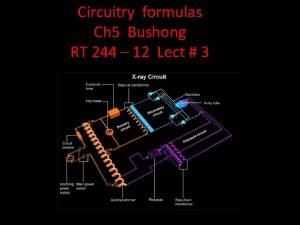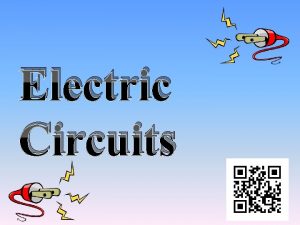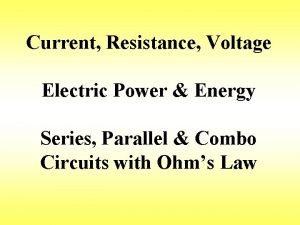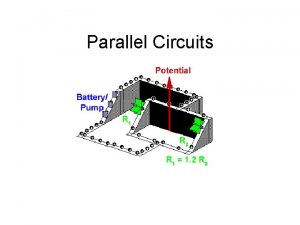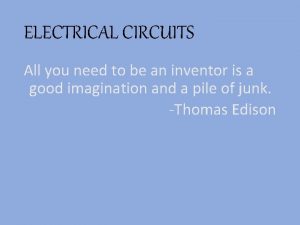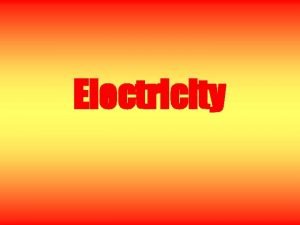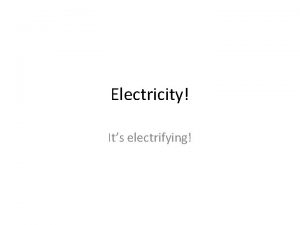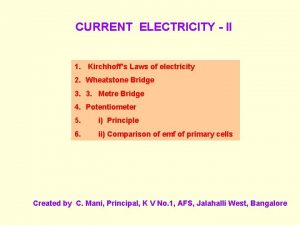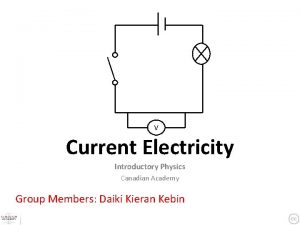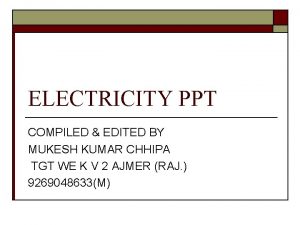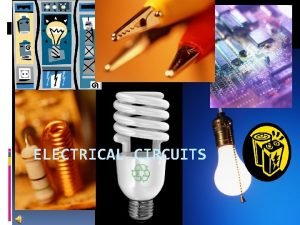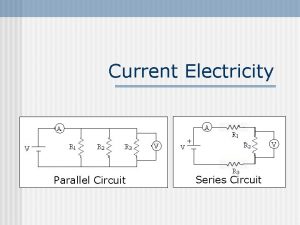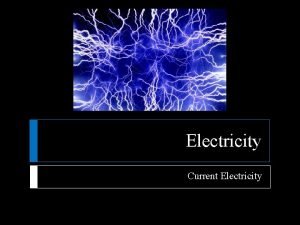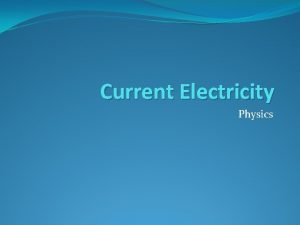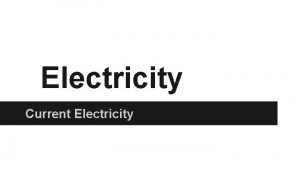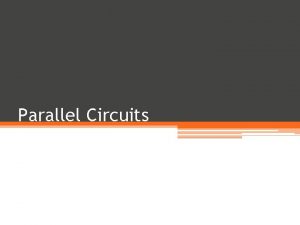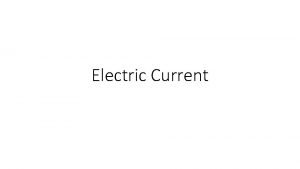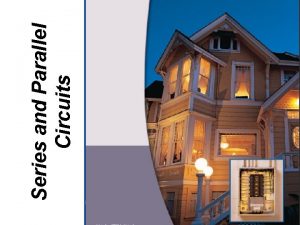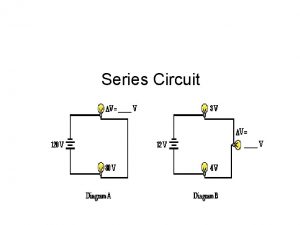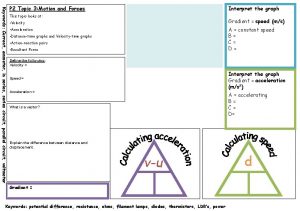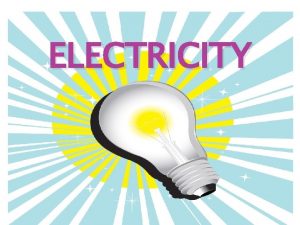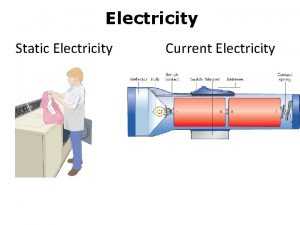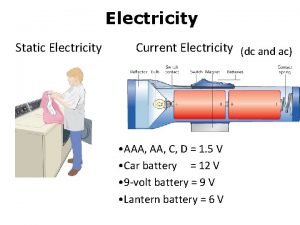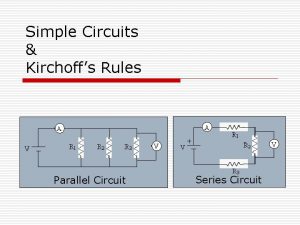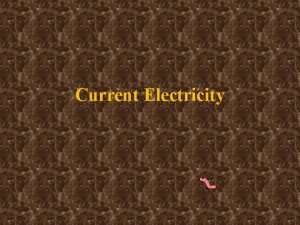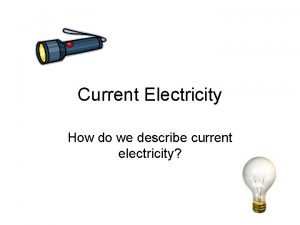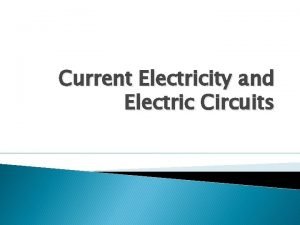Current Electricity Parallel Circuit Series Circuit What You


























- Slides: 26

Current Electricity Parallel Circuit Series Circuit

What You Will Learn n n Transfer of energy in circuits. Conversion of energy. Electric Current – Conventional vs. Flow of Electrons Resistance and Ohm’s Law Basic Circuits

What You Already Know n n n You flip a switch to turn on a light, TV or computer. To turn on the car, you turn the ignition switch. MP 3 players, cell phones and flashlights have on/off switches and use batteries. n In each of these cases, you have a closed circuit in which electricity flows.

What You Already Know n Charge by Conduction – The process by which electrons are transferred from one object to another because of differences in excess number of electrons on one surface compared to the other.

What You Already Know Electric Potential n the Electric Potential Difference is equal to the Work required to move a test charge in an electric field divided by the magnitude of the test charge. F is constant since the electric field is constant from one plate to the other. + + + + A B qo F = qo. E Uniform Electric Field Vtotal = W/qo = Fd/qo = Ed -

Creating a Circuit Plate with excess number of electrons Two equal and oppositely charged plates + + + + Plate with deficiency of electrons - What would happen if a conductor was connected to both plates?

Creating a Circuit The electrons would flow from the negatively charged plate to the positively charged plate until the amount of charge was the same for both plates and the wire. + -+ + + + -+ + Conventional Current Flow - - - + - + -+ - + - + - Electron Flow -+ + + _+ + + How do we maintain the flow of current?

Creating a Circuit + + + + Electron Flow - Charge pump • Battery • Generator • Gas/Oil • Nuclear • Hydro • Wind • Tidal • Solar Circuit: • A closed loop in which electric current can flow. • It generally includes a device such as a light bulb that reduces the electric potential energy. • It also includes a device to increase potential energy (Charge Pump).

What is Current? n Current is the rate of flow of charge. I = q/t = 1 Coulomb/second = 1 Ampere (A) n n Conventional Current = flow of positive charge. (Note that positive charges do NOT flow in metallic conductors. ) Electron flow is simply the flow of electrons.

Ohm’s Law n German Georg Simon Ohm discovered that the ratio of the potential difference to current is a constant for a given conductor. R = V/I Where: R = Resistance in Ohms ( ) V = Electric Potential in Volts (V) I = Current in Amperes (A) n n Resistance is the hindrance to the flow of charge. Most metallic conductors obey Ohm’s Law.

Ohm’s Law n n n The resistance (R) represents the slope (m) of a curve where V is plotted against I. What is R? 10 For Ohmic materials, the curve is a straight line. m = R = V/I Non-Ohmic e. g. light bulb

Examples: Ohm’s Law n How much current flows through a 12 flashlight bulb operating at 3. 0 volts? n What is the voltage drop in a 5 resistor that has 2 amperes of current running through it? n What is the resistance of a heating element in a toaster operating at 120 volts with a current flow of 2 amperes?

What causes resistance? n E-field in conductor (resistor) is provided by a battery or voltage source. n n Charges (electrons) are put in motion due to influences of the electric field, but scatter in a very short time from things that get in the way defects, lattice vibrations (phonons), etc The more collisions, the greater the resistance and the fewer the collisions, the less the resistance. Imagine trying to run down the hallway in between periods versus running down the hallway during the period when there is nobody in them. The latter would be much easier.

How fast do the electrons travel? n n A simple observation would tell an observer that the flow of electricity appears to be instantaneous when flipping on a light switch. Does that mean the electrons travel at the speed of light?

Drift Velocity n + + + + + When an electric field is applied to a conductor, it will set the electrons in motion in an overall direction opposite the applied field. e n n - While the electric field travels at nearly the speed of light, the overall drift speed of the electron from one end of the conductor to the other is quite slow and random in direction due to collisions. For a 20 A circuit in your home with 1 A of current flow, the electrons would only travel 0. 08 m (8 cm) in 1 hour!

Resistivity & Resistance n n Resistivity is a measure of the conductive ability of the material. Resistivity is an intrinsic (natural) property of a material. The higher the resistivity, the higher the resistance and vice versa. For a conductor of length L (m) and cross-sectional area A (m 2), the resistance can be determined by: R = L/A Where = resistivity ( • m) L = length of the conductor A = Cross-Sectional Area

Ex. : Resistance & Resistivity 1. What would happen to the resistance in a wire if the length were increased? A. B. C. 2. What would happen to the resistance in a wire if the crosssectional area were increased? A. B. C. 3. It would decrease. It would increase. It would remain the same. What would happen to the resistivity the length were increased? A. B. C. It would decrease. It would increase. It would remain the same.

Low Resistance vs. High Resistance n To Summarize: n Short fat wires make good conductors. I n Short & Fat = Low Resistance While long skinny wires make poor conductors. I Long & Skinny = High Resistance

Resistance vs. Length and Resistance vs. X-Sectional Area n Resistance and Length? Resistance and XSectional Area? Length X-Sectional Area What is the relationship between:

Resistivity vs. Temperature Note: The Resistivity is zero at 0 K, therefore, the resistance is also zero.

Power n Power = Rate at which work is done where: P = VI P = 1 Joule/second = 1 Watt P = VI = (1 Volt) • (1 Ampere) = 1 Watt V = W/q = 1 Joule/Coulomb I = q/t = 1 Coulomb/second Since V = IR and I = V/R: P = IRI = I 2 R P = V • V/R = V 2/R

Example (Power) What is the power rating of a lightbulb in circuit where the current is 0. 50 A and the voltage is 120 V? P = VI P = 120 V • 0. 50 A P = 60 VA = 60 W

Power vs. Current and Power vs. Voltage (Ohmic Materials) n What is the relationship between: n power and current? Current P = I 2 R Power and voltage? Voltage P = V 2/R

Energy n Since power is the rate at which work is done the amount of energy required to complete a task is as follows: Total Energy = Power x time W = Pt

Example (Energy) How much energy is consumed by a lightbulb operating in circuit where the current is 0. 50 A and the voltage is 120 V for 1 hour? W W = = VIt 120 V • 0. 50 A • 3600 s 216, 000 J 216 k. J

Key Ideas n n n n A circuit is a closed path where current can flow. Current is the flow of charge. Resistance is the hindrance to the flow of charge. Ohm’s Law = voltage to current ratio (V/I) = Resistance. Resistivity is an intrinsic property of a material that is proportional the resistance. An increase in length of a conductor will increase resistance. An increase in cross-sectional area of a conductor will decrease resistance. Power equals the rate at work is done and is represented electrically by P = IV.
 Static electricity and current electricity
Static electricity and current electricity Static electricity and current electricity
Static electricity and current electricity How are static electricity and current electricity alike
How are static electricity and current electricity alike Advantages of parallel circuits over series circuit
Advantages of parallel circuits over series circuit Series vs parallel diagram
Series vs parallel diagram Type of circuits
Type of circuits Series vs parallel circuit
Series vs parallel circuit Klews chart
Klews chart Current in series circuit formula
Current in series circuit formula Circuits activator answer key
Circuits activator answer key How to calculate total resistance in a parallel circuit
How to calculate total resistance in a parallel circuit Short circuit in circuit diagram
Short circuit in circuit diagram Difference between series and parallel circuit
Difference between series and parallel circuit Parallel circuit examples
Parallel circuit examples Draw a series circuit
Draw a series circuit Circuit construction kit
Circuit construction kit What is electrical
What is electrical Electrons flowing
Electrons flowing Electricity def
Electricity def Bill nye electricity
Bill nye electricity Current electricity
Current electricity What is current electricity in physics
What is current electricity in physics Current electricity ppt
Current electricity ppt What slows down the flow of electricity in a circuit
What slows down the flow of electricity in a circuit Y connected generator
Y connected generator Line current and phase current
Line current and phase current Drift current and diffusion current
Drift current and diffusion current








